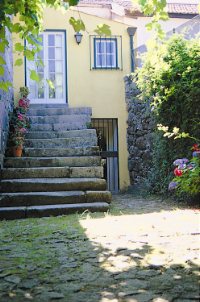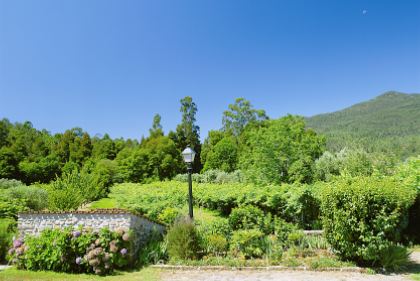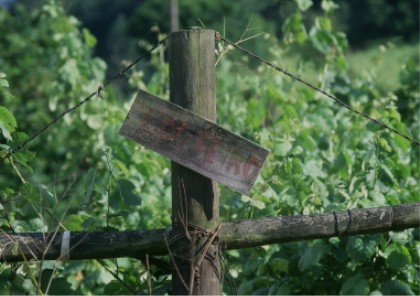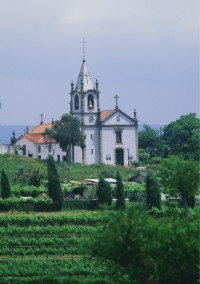Portugal is often associated only with Port, Madeira, Vinho Verde and cheap rosé wines - wrongly. Because the country with its approx. 300 autochthonous grape varieties has much more to offer. Viticulture has a centuries-old tradition. In 1756, the Douro region was declared the first protected and demarcated wine-growing area in the world. A boom was followed by many years of slumber. Young winegrowers have now taken over the reins and are trying to rejoin the wine world with quality. One can look forward to pleasant surprises.
Winegrowing has a tradition in Portugal that goes back over 2000 years and can be traced back to the Phoenicians. Even today, special methods of wine production bear witness to this valuable heritage. For example, in the country's largest province, Alentejo, talhas, large clay amphorae, are still traditionally used as fermentation vessels. Approximately 300 autochthonous grape varieties are known in the land of climatic contrasts and geographical contrasts. This combination makes possible the unique variety of wines with their own character.
Vines are cultivated on 400 000 hectares. This corresponds to fifth place in an international comparison. However, only 8.5 million hl are produced on average - that is just enough for eighth place at present. Almost 80 per cent of this is consumed domestically.
At present, 19 regions of the 40 quality wine areas enjoy DOC status. The Denominacao de Origem Controlada was introduced when Portugal joined the EU. It is based on the French AOC system. The most important DOC areas, besides the two dessert wine appellations Madeira and Porto are: Vinho Verde and Douro in the north, Bairrada and Dao in the heart of Portugal. Following at some distance in the south are Alentejo, Palmela and Setubal, and around the capital Lisbon Colares, Carcavelhos and Bucelas.
25 other areas are designated as IPR, Indicacao de Proveniencia Regulamentada. These regions show how much Portugal is in the mood for change. After five years of steady development with corresponding quality, the IPR areas can be 'upgraded' to DOC. But at the moment, the sleeping wine giant Portugal is quite reluctant to do so; they would rather grow slowly and healthily.
 Visitors are welcome in the quintas, as the wineries are called, comparable to the term chateaux. The caves, or cellars, also invite visitors to taste the wine. Many quintas and caves also offer places to stop for refreshments or even overnight stays. Independent wine tourism is still quite unknown, but initial efforts to set up complete wine routes are already underway.
Visitors are welcome in the quintas, as the wineries are called, comparable to the term chateaux. The caves, or cellars, also invite visitors to taste the wine. Many quintas and caves also offer places to stop for refreshments or even overnight stays. Independent wine tourism is still quite unknown, but initial efforts to set up complete wine routes are already underway.
The whole of Portugal is divided into eight wine regions. Unlike in other countries, the quality "Vinho Regional" does not correspond to an intermediate category of quality wine and table wine. Rather, here you will find high-quality wines that can definitely keep up with the quality wines. The reason for the classification can be a location outside the defined quality wine regions or an unapproved grape variety. The country wine regions of Minho, Tras-os-Montes, Beiras, Ribatejo, Estremadura, Alentejano, Terras do Sado and Algarve produce both earthy and fine wines. In addition, there are high-quality grape variety specialities.
Organic viticulture is practised by only a few. But increasing demand has brought movement here as well. The wines of Portugal are always good for a surprise, you just have to get involved. They are like the country: characterised by contrasts; down-to-earth and multi-faceted.
The wine-growing region is located in the north-west of Portugal and is known as "Entre-Douro-e-Minho" because it lies between the two rivers and the Atlantic Ocean. The vineyards nestle against the mountains as if in a huge amphitheatre, whose steps begin at the Atlantic and rise gently in green terraces to 1400 metres. Humid sea breezes favour high rainfall of up to 2000 mm per year, with even temperatures. The valley is lush green all year round. This is where the name "Vinho Verde" comes from - it is not a character designation, which, as is often assumed, comes from a particularly early and still green harvest time. The soils are not very deep and consist almost exclusively of weathered granite and, in places, permeable sand. Typical for the region is the high cultivation of the vines. The vines border fields as pergolas, form romantic walkways and arbours. They grow on poles or trees up to six metres high. This makes a visit to the region a special experience, especially during harvest time - harvesting is done with a ladder. There are two reasons for this form of cultivation. Firstly, it prevents the high humidity near the ground from rotting the berries. In addition, the vines provide sun protection, allowing the farmers to grow all kinds of vegetables in the shady soil.
Unfortunately, in recent years, some winegrowers have switched to modern, low-maintenance trellis cultivations that can also be worked by machine. However, this trend is already on the decline again, as winegrowers have realised that class sells better than mass. With a vineyard area of 50,000 hectares, Vinho Verde is Portugal's largest DOC region. In 1908, it was the first region to be given this status in order to distinguish itself as a quality wine region. The consequences were not lacking; soon Portugal's best-known and most exported white wines by far came from Vinho Verde. It is all the more surprising that the tradition actually lies in the red Verde. It still accounts for around 50 percent of the annual production of 150 million litres on average. Red Verde is very rare outside Portugal. This deep red-black-violet, sparkling wine, which is always cool to drink, is consumed almost entirely domestically. You have to be a connoisseur to enjoy the world's sourest and lightest red wine. But a red Verde is always worth a try. The tart wine goes perfectly with regional cuisine, is a "wine even for thirst", as locals put it.

Vinho Verde is divided into six sub-regions, as the large vineyard area produces different characters. The typical light Vinho Verde comes from the sub-regions Basto, Braga, Penafiel, Amarante and Lima. The more alcoholic and full-bodied white wine from the Alvarino grape, which comes from the Moncao sub-region, is clearly different. The regions differ not only in slightly different soil types and climatic influences, but also in the permitted and recommended grape varieties.
Trajadura, Avesso, Pederna Loureiro and the acid-rich but verde-typical Azal grape dominate in the white area. With its fine aromatic bouquet (nutmeg), Loureiro in particular has found many friends. Richer in complex aromas, round body and alcohol, however, is the Alvarinho grape. It is considered the queen of the region and is grown high in the north, on the border with Galicia. Alvarinho wines can have up to 13 percent alcohol. This is probably one of the reasons why most of the production is not exported. Among the red varieties, a total of eight are recommended. The unbeatable classic among them is the deep dark Vinhao. This late-ripening variety makes good use of the last rays of sunlight, bringing lots of colour and tannin into play. But it is the lean sparkling white wines with low alcohol that have made Vinho Verde famous all over the world. Next to Port, it is the most important export wine. With a meagre 8.5 to 11 percent alcohol, it has no equal. Nevertheless, it does not seem insipid, but even extremely pleasant due to its lively, carbonated finish. On the whole, the wines of the wineries are quite dry, often recognisable by the word 'seco' on the label. The products of the cooperatives usually differ slightly; they have secured a slight residual sweetness. Therefore, they appear more pleasing in their semi-dry way, without intrusive sweetness. The interplay of distinctive acidity, freshness and slender character makes the white Vinho Verde an ideal companion to culinary delights from Neptune's realm. Young people in particular also like to take it, at a slightly lower temperature, as a "terrace wine or aperetif.
Since Vinho Verde is a household name for many visitors to Portugal, the number of tourists has steadily increased in recent years. Every little town has spruced up its sights, and there are quite a few of them, and the quintas and caves have also prepared themselves for visitors. Wine tastings and cellar tours are quite common.
The sleepy little town of Amarante is definitely worth a visit, and it's a good place to stop. You should taste the regional specialities in various small restaurants on the beautiful terraces above the Rio Tamega - and make some refreshing discoveries, especially in the area of inconspicuous country wines. The church and monastery of S. Goncalo date from 1620 and radiate a particularly sublime charm. If the weather is not so nice, you can save the day with a visit to the Museo Municipal Souza Cardoso. The largest collection of the artist's works is on display there. A walk across the historic Ponte de Amarante (1620) is also worthwhile.
In the neighbouring town of Arcos de Valdevez is the Monastery do Ermelo. On a large open-air site, 24 rural granaries from various periods are set up, some dating from around 1782. In Guimaraes, the tenth-century Castelo is clearly visible from afar. It towers loftily as the historical centre of the city. The palace of the Duques de Braganca houses a historical museum. Small cosy wine taverns, often furnished only with bare wooden tables and a few chairs, invite you to linger and enjoy a glass of wine from regional winegrowers.
You can also stay overnight with some producers. The castle-like mansion Casa de Sezim, dating from the 17th century, is particularly beautiful. The owner, Mesquita, speaks excellent English and his wines speak for themselves. (Casa de Sezim, Santo Amaro, 4800 Guimaraes, F +351 253 523000, F +351 253 523196).
 |
| Casa de Sezim |
Especially for lovers of seafood, the table is richly set in the area around Viana Castelo. More than 1000 different recipes are known for balcalhau, stockfish, alone. Shellfish such as lobster, langoustines and prawns are also frequently offered at relatively low prices. As a speciality, sapateira, a particularly large type of crab, is served. In some restaurants it is customary for the waiter to serve a wooden mallet with the sapateira. Then the guest must (may) crack open the crab legs himself. The crab is seasoned with a spicy sauce made from fresh herbs. A fresh white Vinho Verde rounds off the taste experience. Sopa Alentejana is also original: a raw egg is added to the clear broth seasoned with lots of garlic at the table. The soup is so hot that the egg is cooked in it. When hunger strikes, sardinhas grelhadas, grilled sardines with various garnishes, are a tasty and cheap remedy. In rural areas in particular, things are much heartier. Caldo Verde, the kale soup with potatoes, peppers and onions, is often eaten in the middle of the high vines after work in the vineyard. A red Vinho Verde goes very well with it. After a leisurely meal, people in Portugal drink a bica (strong, black coffee) or the brandy variety aguardente. Sometimes the liqueur Licor beirao, which tastes of apricots, almonds and a little aniseed, is served. With sweet little pastries and cakes, the bolos, but also with fish and seafood, you can actually seduce a Portuguese around the clock. The small delicacies are available in a large selection in cafés and restaurants.
Forty kilometres from the coast is Braga. The greenery and the traces of the Renaissance with its fountains and gardens quickly distract from the actual industrial city. The Renaissance was followed by the Baroque - austere architecture gave way to pomp. You can gain an insight into the feudal life of this period in the Palacio dos Biscainhos. It is furnished with original pieces. The typical azulejo tiles, which are often bought as souvenirs, depict the life of the noble citizens.
 |
| Sogrape Barcelos |
Even the stables were tiled with blue tiles. "Cog railway or on foot?" is the question before the ascent to the pilgrimage church of Bom Jesus do Monte. After all, the ladder to heaven to the dear Jesus has 500 steps. The imposing showpiece is both a station path and a grand staircase. Several terraces interrupt the building, which is decorated with statues. Each fountain symbolises one of Jesus' stations. At the beginning his wounds, then the five senses and at the end the classical virtues. At the top, you have a wonderful view from 572 metres above the expanse of the Minho.
Every Thursday is the weekly market in Barcelos. It is very rural and is considered the liveliest and most colourful in Portugal. In addition to fruit and vegetables, poultry - made from baked clay - is also sold.
Galo, the symbolic clay rooster, has become a national souvenir.
ADEGA COOP. PONTE DE LIMA
R. Conde de Bertindos, 4990 Ponte de Lima,
T +351 258 741449, F +351 258741448.
Guided tour of vineyards, cellar and production, wine tasting, sale,
Refreshments available
CASA DE SEZIM
Nespereira, 4800 Guimaraes,
T +351 253 523000, F +351 253 523196.
Guided tour of vineyards, cellar and production, wine tasting, sale,
hotel, beautiful surroundings.
COOP. AGRICOLA DE FELGUEIRAS
Idanhas-Margaride, 4610 Felgueiras,
T +351 255 312666, F +351 255 312668.
Guided tour of the cellar, wine tasting, sale
PROVIVERDE
Av. 1 de maio, Sao Goncalo, 4600 Amarante,
T 351 255 422069, F +351 255
432790
Guided tour of vineyards, cellar and production, wine tasting.
CASA DE OLEIROS
Travanca, 4600 Amarante,
T +351 255 732375, F +351 255 5489221
Guided tour of cellar and production, wine tasting, sale,
refreshments, beautiful surroundings
CASA DO VALLE
Moimenta - Cavez, 4860 Cabeceiras de Basto,
T +351 2 6176594, F +351 26106573
Guided tour of cellar and production, wine tasting, sale,
refreshments, hotel.
QUINTA DE COVALE
Sao Tome de Covelas, 4640 Baiao,
T +351 254 98412, F +351 254 885225
Guided tour of vineyards, cellar and production, wine tasting, sale,
refreshments, beautiful surroundings
PACO DE TEIXEIRO
Mesao Frio, 5040 Cidadelhe M.S.F.,
T+ 351 254 899269, F +351 254 899887
Guided tour of cellars, wine tasting, sale.
CASA DE VILLA VERDE
Caide de Rei, 4620 Lousada,
T +351 255 821450, F +351 255 821450
Guided tour of vineyards, cellar and production, wine tasting, sale,
refreshments, beautiful surroundings, historic building.
CASA DE VILA BOA
Vila Boa de Quires, 4630Vila Boa de Quires,
T +351 255 535714, F +351 255535714
Guided tour of vineyards, cellar and production, wine tasting, sale,
refreshments, beautiful surroundings, historic building.
SOLAR DE BOUCAS
Lugar de Ancede - Prozelo,
4720 Amares,
T +351 253 909010, F +0351 253 909019
Guided tour of cellar and production, wine tasting, sale, beautiful surroundings.
More information from the author at redaktion@kopp-press.de